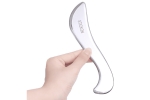How to Use a Massage Scraping Tool for Quad Tightness

Graston Technique is a form of manual therapy that uses specialized instruments to perform soft tissue mobilization. When using Graston Technique for quad tightness, the goal is to reduce adhesions and restrictions in the muscle tissue, improve circulation, and promote tissue healing.
Here's how to use Graston Technique for quad tightness:
-
Prepare the Area: Before using the Graston Technique, it's essential to prepare the skin and muscle tissue. Clean the skin thoroughly with soap and water to remove any oils, lotions, or debris. You may also apply a small amount of lubricant, such as massage oil or lotion, to the skin to reduce friction during the treatment.
-
Select the Appropriate Graston Tool: Graston Technique utilizes specialized stainless steel instruments of various shapes and sizes to perform soft tissue mobilization. Choose a Graston tool that is appropriate for the size and contours of the quadriceps muscles. The tool should have a smooth edge and be comfortable to hold and manipulate.
-
Apply Lubricant: Apply a small amount of lubricant to the skin over the quadriceps muscles. This helps reduce friction and allows the Graston tool to glide smoothly over the skin during the treatment.
-
Perform Soft Tissue Mobilization: Hold the Graston tool at a comfortable angle and gently glide it over the surface of the quadriceps muscles in the direction of muscle fibers. Apply light to moderate pressure to the skin, focusing on areas of tightness, tenderness, or restriction. Use short, overlapping strokes to cover the entire length of the quadriceps muscles.
-
Address Adhesions and Restrictions: When you encounter areas of adhesions or restrictions in the muscle tissue, apply slightly more pressure with the Graston tool to target these areas specifically. Use a combination of scraping, sweeping, and cross-friction techniques to break up adhesions, release trigger points, and improve tissue mobility.
-
Monitor Sensation: Pay attention to feedback from the client or patient during the treatment. The sensation experienced during Graston Technique may vary from mild discomfort to a deep stretching or tingling sensation. Adjust the pressure and technique as needed to ensure the treatment is comfortable and well-tolerated.
-
Repeat as Needed: Depending on the severity of quad tightness and the individual response to treatment, you may repeat the Graston Technique session multiple times to achieve the desired outcome. Be mindful of tissue response and avoid over-treatment to prevent irritation or bruising.
-
Follow Up with Stretching and Exercise: After performing Graston Technique for quad tightness, it's essential to follow up with stretching and strengthening exercises to maintain flexibility, mobility, and muscle balance. Incorporate quad stretches, foam rolling, and strengthening exercises into the rehabilitation program to optimize outcomes and prevent recurrence of tightness.
It's important to note that Graston Technique should be supervised by trained healthcare professionals who have received certification and proper training in the technique.
This ensures safe and effective application of the technique and reduces the risk of injury or adverse effects.
If you're experiencing quad tightness or other musculoskeletal issues, consult with a qualified healthcare provider who can assess your condition and determine the most appropriate treatment approach for your needs.



